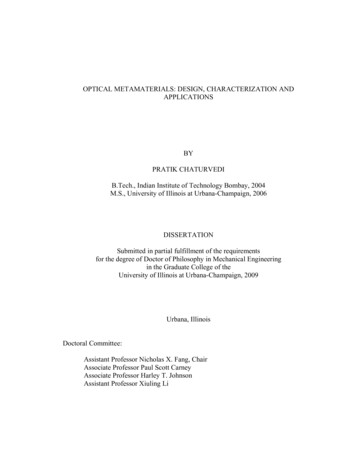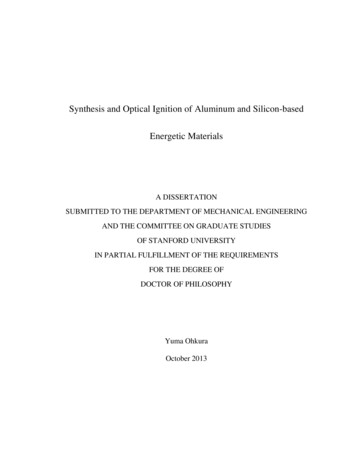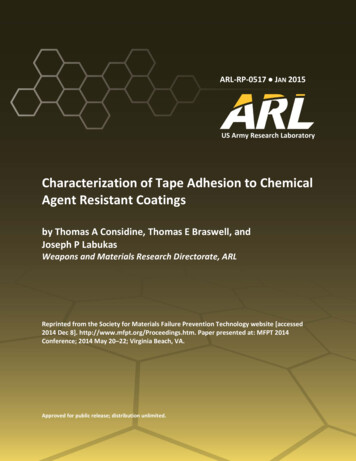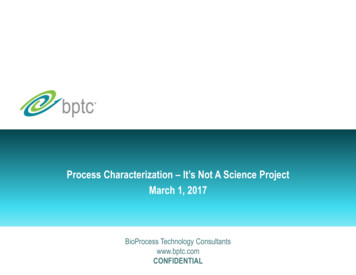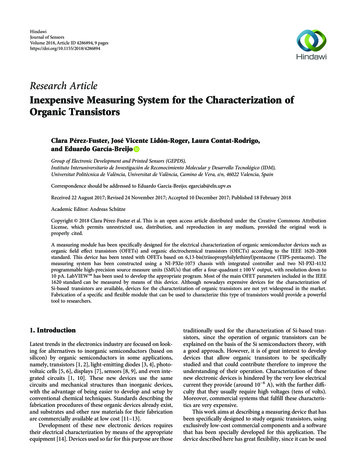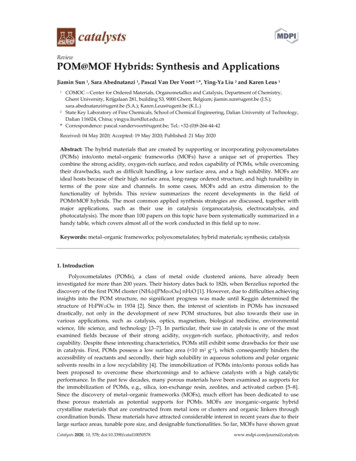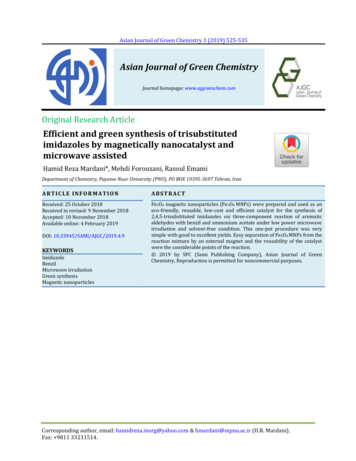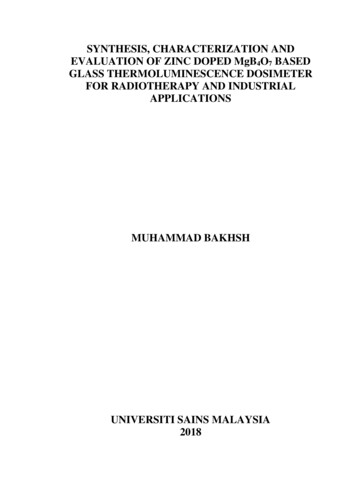
Transcription
SYNTHESIS, CHARACTERIZATION ANDEVALUATION OF ZINC DOPED MgB4O7 BASEDGLASS THERMOLUMINESCENCE DOSIMETERFOR RADIOTHERAPY AND INDUSTRIALAPPLICATIONSMUHAMMAD BAKHSHUNIVERSITI SAINS MALAYSIA2018
SYNTHESIS, CHARACTERIZATION ANDEVALUATION OF ZINC DOPED MgB4O7 BASEDGLASS THERMOLUMINESCENCE DOSIMETERFOR RADIOTHERAPY AND INDUSTRIALAPPLICATIONSbyMUHAMMAD BAKHSHThesis submitted in fulfilment of the requirementsfor the degree ofDoctor of PhilosophyApril 2018
ACKNOWLEDGEMENTIn the name of Allah, the most gracious, most merciful. Praise to Allah S.W.T,peace and blessings of Allah upon his messenger, Muhammad S.A.W, and all his familyand companions. I am grateful to Allah S.W.T who gave me the courage and strengthto complete this research in due time.I would like to express my deepest gratitude to my main supervisor Dr.Iskandar Shahrim bin Mustafa as well as my field supervisor Dr. Wan Saffiey WanAbdullah, for their scientific as well as moral support, guidance and encouragementthroughout this research journey. Special thanks to Prof. Dr. Husin Wagiran and Dr.Muhammad Alam Saeed, from UTM, for their valuable suggestions and fruitfuldiscussions. I am sincerely grateful to The World Academy of Sciences (TWAS) andUniversiti Sains Malaysia (USM) for their financial support, in the form of TWASUSM fellowship, during this research.I am grateful to my beloved family my father (Lutuf Ali Nizamani), my mother(Hawol), my wife (Faiza), my son (Prince Muhammad Zain), my daughter (PrincessAiza), my brothers and my sisters for their precious love, encouragement andconsiderable patience.I would like to offer my deepest gratitude to my uncle Dr. Shafi MuhammadNizamani and my late aunt Mumtaz Shafi Nizamani for their encouragement, guidanceand support throughout this journey.Special thanks to Fatema Mohammed Ali Abdo for her love, support andencouragement during the critical stage of this research journey.I would like to offer special gratitude to Dr. Gokula Kumar, Dr. MohammedHafiz and Dr. Mohammed Zahri from Institut Perubatan dan Pergigian Termaju(IPPT), USM for their generosity and support.ii
I offer sincere thanks to Mr. Mohamed Mustaqim Abu Bakar, Mr. Mohd RizalBin Mohamad Rodin, Mr. Hazhar Hassan and Miss Ee Bee Choo from school ofPhysics, Universiti Sains Malaysia as well as Mr. Saiful Rashid and MuhammadSalehuddin Baharuddin from Universiti Teknologi Malaysia and Mr. Suhaimi, Mr.Azizi and Madam Nor Hayati from Malaysian Nuclear Agency for their assistance,technical and non-technical support during this research.Finally, many thanks to everyone else who helped me directly or indirectlythroughout this journey.Muhammad Bakhsh Nizamaniiii
TABLE OF CONTENTSACKNOWLEDGEMENT . iiTABLE OF CONTENTS . ivLIST OF TABLES . viiiLIST OF FIGURES . ixLIST OF SYMBOLS AND ABBREVIATIONS . xiiABSTRAK . xviABSTRACT . xviiiCHAPTER 1- INTRODUCTION -------- 11.1Introduction . 11.2Problem Statement . 61.3Research Objectives . 71.4Scope of Research . 81.5Research Significance . 81.6Thesis Design . 9CHAPTER 2- LITERATURE ---- 102.1Introduction . 102.2Radiation Dosimeter . 102.3Thermoluminescent Dosimeter . 112.4Characteristics of Thermoluminescent Dosimeter . 122.4.1Batch Homogeneity. 122.4.2Glow Curve . 132.4.3Annealing (Thermal treatment) . 152.4.4Time Temperature Profile (TTP) . 162.4.5Effective Atomic Number (Zeff) . 162.4.6Sensitivity. 172.4.7Energy Response . 18iv
2.4.8Dose Response . 202.4.9Fading. 212.4.10Minimum Detectable Dose . 222.4.11Reproducibility. 232.5Magnesium Borate based TL Dosimeter . 232.6Glass . 362.6.1Thermal Analysis . 362.7Magnesium Borate Glass . 372.8Kinetic Models . 392.92.8.1Randall-Wilkins Model (First-Order Kinetics) . 392.8.2Garlic-Gibson Model (Second-Order Kinetics) . 402.8.3May-Partridge Model (General-Order Kinetics) . 41TL Glow Curve Analysis . 412.9.1TL Parameters . 422.9.1(a) Frequency Factor (S) . 422.9.1(b) Activation Energy (E) . 422.9.2Methods of Analysis . 432.9.2(a) Initial Rise Method . 432.9.2(b) Peak Shape Method . 44CHAPTER 3- MATERIALS AND METHODS --------------------------------------- 463.1Introduction . 463.2Glass Fabrication . 483.3Physical Parameters . 503.43.3.1Density and Molar Volume . 503.3.2Boron-Boron Separation . 50Characterization . 523.4.1XRD Analysis . 52v
3.53.4.2FESEM Analysis . 523.4.3Energy Dispersive X-ray Spectroscopy (Elemental composition) . 533.4.4Differential Scanning Calorimetry (Thermal Analysis) . 53Sample Irradiation . 543.5.1Gamma Sources . 543.5.2Linear Accelerator (LINAC) . 563.6TLD Reader . 573.7Optimization . 573.7.1Sample Composition . 573.7.2Heating Rate . 583.7.3Annealing . 583.7.3(a) Annealing Temperature . 593.7.3(b) Annealing Time . 593.8Initialization . 593.9Dosimetric Evaluation . 60CHAPTER 4- RESULTS AND DISCUSSION ----------------------------------------- 614.1Sample Synthesization . 614.2Characterization . 634.2.1Physical properties . 634.2.2Phase analysis . 694.2.3Surface Morphology. 714.2.4Elemental Composition . 734.2.5Effective Atomic Number . 764.2.6Thermal Analysis . 774.2.7Kinetic parameters . 794.2.7(a) Peak shape method . 804.2.7(b) Initial rise method . 82vi
4.34.4Optimization . 844.3.1Heating rate . 844.3.2Glass composition . 884.3.3Batch Homogeneity. 924.3.4Annealing . 95Dosimetric Evaluation . 994.4.1Reproducibility. 994.4.2Dose response (Linearity) . 1004.4.2(a) Low dose (Therapeutic Beam Irradiation) . 1014.4.2(b) High dose (Gamma Cell Irradiation) . 1054.4.3Minimum detectable dose . 1064.4.4Sensitivity. 1074.4.5Energy response . 1094.4.6Fading and signal stability . 1104.4.6(a) Optical fading . 1104.4.6(b) Thermal fading . 1124.5Summery . 114CHAPTER 5- CONCLUSION -------- 1155.1Conclusion . 1155.2Future recommendations . 117REFERENCES. 119LIST OF PUBLICATIONSvii
LIST OF TABLESPageTable 2.1Characteristics of previously studied magnesium boratebased TLDs . 33Table 4.1Chemical compositions of synthesized glasses . 62Table 4.2Physical parameters calculated for prepared glass series . 65Table 4.3Elemental composition of synthesized glasses . 74Table 4.4Effective atomic numbers of proposed thermoluminescentdosimeter . 76Table 4.5Thermal parameters of prepared glasses obtained from DSCtraces . 77Table 4.6Kinetic parameters determined for undoped, Zn doped andLi co-doped MgB4O7 using peak shape method . 80Table 4.7Kinetic parameters determined for undoped, Zn doped andLi co-doped MgB4O7 using initial rise method . 84Table 4.8Minimum detectable dose and associated parameters forsynthesized glass series . 107Table 4.9Sensitivity of standard TLD-100 and the proposed dosimeters . 108Table 4.10Characteristics of synthesized dosimeters . 114viii
LIST OF FIGURESPageFigure 2.1A standard Differential Scanning Calorimeter thermogramof glass . 37Figure 2.2Boroxol ring structures in alkali borate glasses and vitreous boricoxide Shelby (2005) . 39Figure 2.3An isolated schematic TL peak Horowitz (1984). 44Figure 3.1Step by step approach adopted in current research . 47Figure 3.2Overall diagram on current synthesized glasses . 49Figure 3.3Low dose gamma irradiation setup using Co-60 teletherapyunit . 55Figure 3.4High dose gamma irradiation setup using Cs-137 gamma cell . 55Figure 3.5Linear accelerator (ELEKTA Synergy) used for sampleirradiation . 56Figure 4.1Glass samples used for dosimetric evaluation . 63Figure 4.2Relationship between density and molar volume for (a) MgB4O7glass series (b) MgB4O7:Zn glass series (c) MgB4O7:Zn,Li glassseries . 68Figure 4.3XRD patterns of (a) undoped MgB4O7 with different ratios (b)MgB4O7 doped with different concentrations of ZnO (c) MgB4O7co-doped with different concentrations of Li2O . 71Figure 4.4FESEM images of (a) undoped (b) ZnO doped and (c) Li2Oco-doped MgB4O7 glasses . 73Figure 4.5EDX spectrum of (a) S3565, (b) S35654 and (c) S356549samples . 75ix
Figure 4.6DSC thermogram of (a) MgB4O7 (b) MgB4O7:Zn(c) MgB4O7:Zn,Li glasses . 78Figure 4.7TL glow curves along with obligatory values of (a) undoped(b) Zn doped (c) Li co-doped glasses . 81Figure 4.8Plot of ln(I) versus 1/kT to evaluate the activation energy (E)for (a) MgB4O7 (b) MgB4O7:Zn and (c) MgB4O7:Zn,Li . 83Figure 4.9Heating rate dependent glow curves of (a) S3565, (b) S35654and (c) S356548 . 87Figure 4.10Heating rate dependent TL response of (a) S3565, (b) S35654and (c) S356548 . 88Figure 4.11Composition dependent glow curves of (a) undoped, (b) Zndoped and (c) Li co-doped glass series. 91Figure 4.12Composition dependent TL response of (a) undoped, (b) Zndoped and (c) Li co-doped glass series. 92Figure 4.13Batch response of (a) S3565, (b) S35654 and (c) S356548glass series with 68% confidence intervals . 94Figure 4.14Annealing time dependent TL response of (a) S3565, (b) S35654and (c) S356548 determined at a fixed temperature of 250 oC . 97Figure 4.15Annealing temperature dependent TL response of (a) S3565,(b) S35654 and (c) S356548 determined at a fixed time of30 min . 98Figure 4.16Signal stability of (a) S35654 and (b) S356548 dosimeters withannealing and without annealing . 100Figure 4.17Dose response of proposed dosimeters subjected to (a) Co-60,(b) 6MV and (c) 10MV therapeutic beams . 103x
Figure 4.18Linearity index f(D) plotted against the dose for the proposeddosimeters subjected to (a) Co-60, (b) 6MV and (c) 10MVtherapeutic beams . 104Figure 4.19Dose response of the proposed dosimeters subjected to Cs-137gamma rays . 105Figure 4.20Linearity index f(D) plotted against the dose for the proposeddosimeters subjected to Cs-137 gamma rays. 106Figure 4.21Energy response of the proposed dosimeters . 110Figure 4.22Optical fading behavior of the proposed dosimeters exposed tofluorescent tube light . 111Figure 4.23Optical fading behavior of the proposed dosimeters exposed tosun light . 112Figure 4.24Thermal fading behavior of proposed dosimeters . 114xi
LIST OF SYMBOLS AND ABBREVIATIONSγGammaoDegree CelsiusµGyMicro GrayAgSilvera.uArbitrary UnitBCBefore ChristBOBoron OxideB2O3BorateCaCalciumCBConduction BandCeCeriumcGyCenti GrayCoCobaltCsCaesiumCuCopperDmaxMaximum depthDSCDifferential Scanning CalorimetryDyDysprosiumEDXEnergy Dispersive X-rayErErbiumEREnergy ResponseENDOEndothermicCxii
EuEuropiumeVElectron VoltEXOExothermicFESEMField Emission Scanning Electron MicroscopyFWHMFull Width at Half MaximumGdGadoliniumGyGrayIECInternational Ele
Iskandar Shahrim bin Mustafa as well as my field supervisor Dr. Wan Saffiey Wan Abdullah, for their scientific as well as moral support, guidance and encouragement throughout this research journey. Special thanks to Prof. Dr. Husin Wagiran and Dr. Muhammad Alam Saeed, from UTM,
